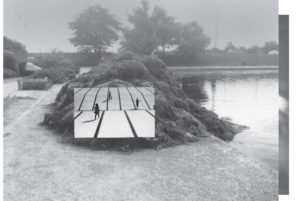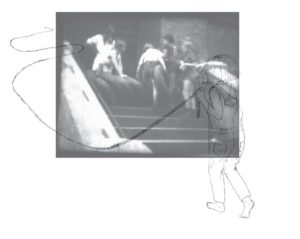THE HAND TELLS STORIES FROM THE RABBITS HOLE
Written and illustrated with Margarita del Carmen
In connection to our project with Der Fahrende Raum, Munich, 2017
Published in Florida Magazine
Available in German and an excerpt here in English:
>
In a conversation with alternative pedagogues in São Paulo, Félix Guattari mentions a certain relation between children, state, neighbourhood and the alternative pedagogic projects that the pedagogues are working on. This relation often leaves the children caught in-between the pedagogic spaces and the state in their internal relation. This relation very often lead the pedagogic projects to be isolated from their contexts, either they conform to the state or become isolated elite institutions. Here the role of the neighbourhood becomes important as the geographical context for the alternative pedagogy.1 It is exactly this awareness of spatial context we seek out when we observe spaces and this is also why Der Fahrender Raum’s insistence of being a nomad in the city, in order to come close to neighbourhoods, can be important in a spatial-pedagogical sense. With this awareness, we can look at the artist-pedagogue as having a concrete role in processes of design. There are some important points to notice when the processes begin to actualize. Here, We have to look at the role of the designer in relation to the pedagogue. When we talk about space as something shared and open for collective action, it is because we too believe that the role of the designer can be more horizontal and more shared between people. In the same way as we say that space is always changing, it seems proper to say that design is always being redesigned by its users. We are beginning to think that it is within this process of redesign, appropriation that our research is really moving. At the same time we hope that from here it is possible for groups in spaces to affect the processes higher up – not possibly without a fight for recognition at first. By this we do not mean that there is no role for the professional designer, planner etc. in these processes, on the contrary we think that the expertise of professionals could play many more roles on many more levels. It is with this in mind that we look at design through pedagogical methods: That the making of a place really comes from catching the social and ecological rhythms of a space, what could make a design, like of a building, could then come out of these rhythms2 – always with a critical eye on the relations of power between different positions. This is why it can work to play with our own positions of power. Like a surrealist dialogue of exquisite corpse where random elements make an unforeseen synthesis, the process forms words and sentences, like the moment when the people leave and the stage and the props start to perform on their own – the hand will tell the building unknown stories from the rabbits hole. (…)
We talk about play and theatre in relation to urban design because we find it important to come up with new ways of creative enunciation. When playing a game things are expressed that over time perhaps give a deeper conception of reality than if one asks a question directly. We are thinking about when citizens are often included in urban planning, it can sometimes feel as if there is an answer to the question, and one has to guess this answer. When working with children, this way of asking direct questions can turn out to be very limiting. For us it is here important to stress that we as pedagogues do not ask questions in order to get answers, likewise we do not ask questions in order to analyse what comes back to us. What we mostly look at is the process in itself, as living and unpredictable as it is. From this process there are enunciations made. When these enunciations come out of a process of collaboration and imagining together, they mean something to us. We as facilitators can then use these enunciations to propose new discussions and activities to go into the process. In this way, we are not always sure of what is going on, we do not have the full control of the situations, but must try to listen as best as possible. In the long run, if a process is very lively and imaginative, it can go on for a very long time and hopefully at a point without us having to facilitate. It is important in this relation, as a facilitator, to be able to let go of the situation and at the same time have a feeling for when to give new inputs. This creates a mode of facilitation with a constant letting-go-taking-hold of the situation – a kind of organic oscillation feeding into the process – adding pollen to a continuously mutating organism. We think that this way of looking at a pedagogical situation in relation to space can both bring out a more subtle spatial awareness from the level of the groups, as well as a creative imagination from which the groups can act and at some points make concrete ideas for the space. This is mainly what our research is trying to seek out and where we see the role of the facilitator, the pedagogue, have an emancipatory, mobilizing effect.
This leads us to think more closely about whose voices are normally heard both in the formal planning processes but also in everyday life. It is clear that in a space there are different groupings that happen for different reasons. Some of these groupings happen by the choice of their members, others are projected onto them by certain marks that are projections from one position to another. The first position is always the normalizing, the first point of departure determined by the group who holds the most power over everyone else (for example the ones with more wealth, of a certain origin, sexuality, gender, age). Doing our work as facilitators, connected to processes, we experience more and more how children perceive their spaces and how this is different to our adult perceptions. We will not mention any of these concrete observations as they need their context for them to be understood. But We would like to underline that the way children seem to us to perceive their space is very different from the way most spaces are generally being designed – even spaces that are supposed to accommodate children. We think that the beginning of this problem is the projections made from the normalizing adult position, and we believe that another way to design could be to start out with the processes of creative expression, taking the flows and rhythms from these situations and thereby begin to make spaces. Now, we as two adults can only begin to try to understand children’s conception of space. We cannot make any conclusions. We feel this comes from, in part, the complexity of the different children and spaces. For us difference is not a limitation but an unknown amount of possible outcomes that can be experienced by a curious and creative process of meeting and making. There is to our knowledge in the broader public and spatial-political sphere a neglect of the pedagogical work focussing on children’s enunciations in space. It seems that there are very few questions asked without a pre-conceived answer when the questions are asked from a normative position – further there seems to be a strong normative insistence in asking questions in exactly this way. We could make coherent critique of this type of questions as tools of power starting with the experiences of everyone from the point of their neighbourhood. Going back to the beginning of this text, when Félix Guattari mentioned how children as a minority group often get caught up, squeezed in, between the state and pedagogues, we also see this happen between the sate and many other professional positions. Perhaps it is time to give minorities a proper voice instead of concentrating on how to contain them. This is the role difference can play in our shared spaces. Last but not least: When we talk about children’s ways of perceiving spaces, how they are different to the ways of adults, doesn’t that make you curious to find out what these spaces are like?
<
1 Félix Guattari and Suely Rolnik, Molecular Revolution in Brazil, pp. 138-145, Semiotext(e), 2008
2 Henri Lefebvre, The Production of Space, p 117 and pp 404-405, Blackwell Publishing, 1991

